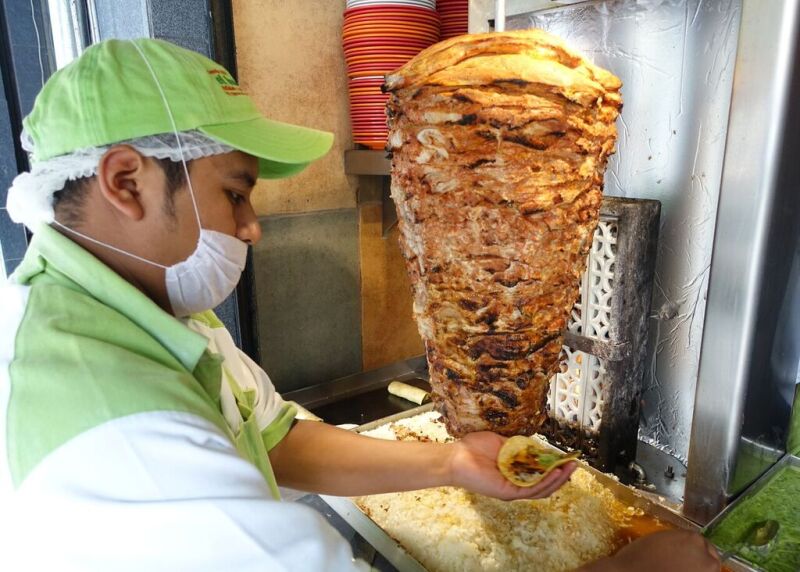Looking for the best tacos in Mexico City? First, you need to understand that a taco isn’t just a taco in the Distrito Federal. In fact, the range of styles is so wide that you probably won’t be able to (comfortably) stomach them all in a single day. With the help of a local taco expert, we dive in and discover the six staples of the taco scene in Metropolitan Mexico.

The spit-roasted pork used for tacos al pastor
Photo by Will McGough
1. Tacos al pastor
An al pastor taco is probably the most well-known Mexican street food—a very simple combination of roast pork on a grilled tortilla. A nighttime favorite for locals, the pork is always slow cooked a vertical spit, and then shaved off into a tortilla.
Some vendors top it with a slice of pineapple, while others don’t. But don’t worry about the pineapple—this taco is all about the flavor of the meat. “The most important thing about al pastor is its pre-Hispanic Adobo marinade,” said Bill Esparza, Co-Founder and Curator of Club Tengo Hambre, a “roving supper club” that offers walking taco tours in Mexico City. “Everyone has their own spin on it.” In other words, ask five locals for their favorite pastor stand and you’ll get five different answers. But that’s not a bad thing—in reality, asking around and following recommendations is a good way to create your own taco tour.
Club Tengo Hambre suggests two stands with long traditions, El Huequito and El Vilsito.
2. Tacos de guisados
El pastor Tacos might ring the most bells for foreigners, but here on the streets of Mexico City, the most popular style is tacos de guisados (pictured at top), small corn tortillas filled with homemade stews and braises, like rellena (blood sausage), chicharron, picadillo (ground beef), chile relleno, tortitas (small savory pancakes), chicken liver —the list goes on and on.
“There are hundreds of guisados, and it’s what everyone remembers from being a kid in a Mexican household,” said Esparza. “You’re headed out the door and you grab whatever your Mom or Grandma made and put it in a tortilla. They are your Monday through Friday tacos for the working class, what people like to eat when they can’t go home. It’s like grabbing a home-cooked meal in a tortilla on the street.” Esparza said the most common guisado is rice with hard-boiled eggs, which vendors use as a base to put stews on so they don’t fall off the tortilla.
Club Tengo Hambre’s suggestion: Tacos Gus

Tacos de canasta
Will McGough
3. Tacos de canasta
Tacos de canasta, or “basket tacos,” are sometimes called Tacos Sudados, or “sweaty tacos.” They are reminiscent of days when workers would open their lunch pails to soggy tortillas, victimized—most likely intentionally—by their wet fillings. The style features more sauce than meat, a tortilla that’s filled with mole verde, adobo, potato, chicharron, or refried beans, then steamed. What results is a very thin, soggy, and pliant taco, one that might even feel greasy to the touch. Locals eat it with pickled vegetables and typically consume it before noon, with stands staying open until they run out in the early afternoon.
Club Tengo Hambre’s suggestion: Los Especiales
4. Tacos de Fritanga
Although the name “fried tacos” sounds safe enough, these tacos are not for the faint of heart, or for that matter, anyone with a gag reflex. The ingredients of a taco de fritanga, which routinely include offal and pig’s brain, are slow-fried in lard in a convex steel disc called a comal de acero. Do as the locals and order up some buche, better known as Hog’s maw, or pig stomach. “The most serious tacos de fritanga scene is in Mexico City,” said Esparza. “Only the Mexican capital has the full spectrum of offal and sheer volume of vendors to own this category.” If you’re not that adventurous, look for brisket or chorizo, two other main fillers commonly found in tacos de fritanga.
Club Tengo Hambre’s suggestion: Tacos “Beto”

Tacos de longaniza
Photo by Will McGough
5. Tacos de Longaniza
You’ll notice long sausages hanging from a rack at stands serving tacos de longaniza. You’ll then notice them being chopped into pieces on a wood board. Mexican longaniza is similar to but spicier than chorizo, and once diced, it is cooked on a flat-top grill in its own juices, ensuring a runny, messy taco upon transfer to a tortilla.
Club Tengo Hambre’s suggestion: Villamelon
6. Make Your Own Tacos
Sometimes, you just want what you want the way you want it. A do-it-yourself taco experience comes in the form of an alambre: A scrambled, stir-fried hash with bell peppers, onions, and cheese topping your choice of meat, served with a side of tortillas. A go-to dinner option for locals on weekends, you can find alambres at taco restaurants on any corner of any neighborhood. “Monday through Friday, the locals go for guisados,” said Esparza. “On weekends, they change over to meat-heavy alambres.”
Club Tengo Hambre’s suggestion: El Pastorcito











